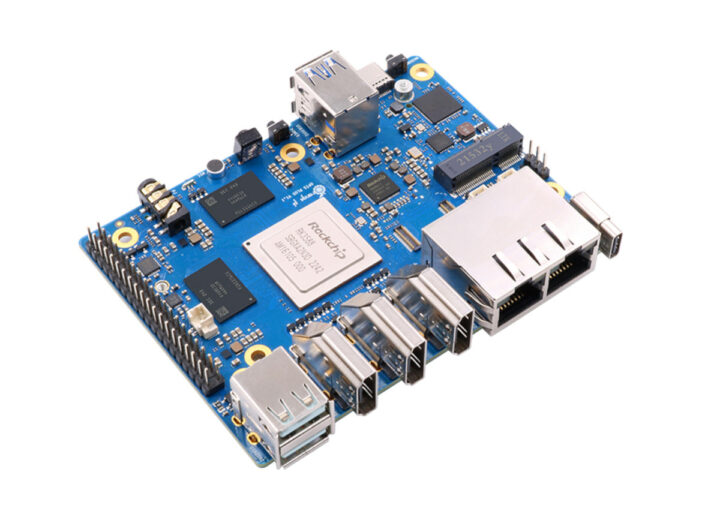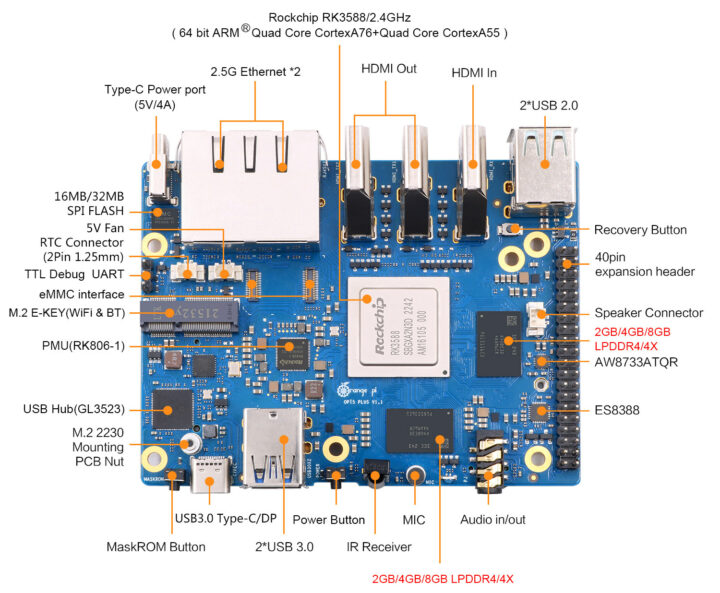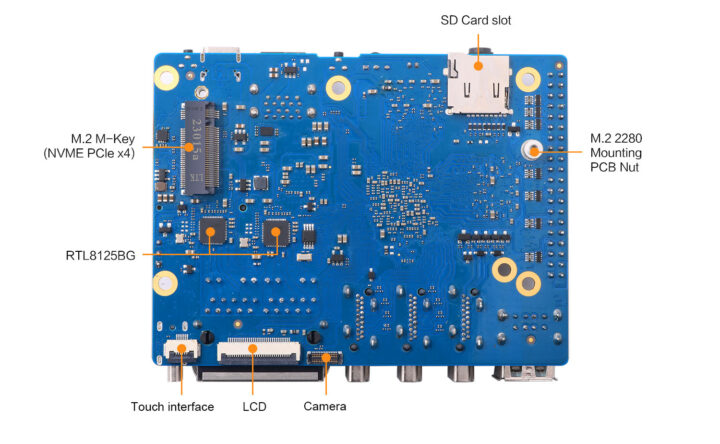Orange Pi 5 Plus is the first Rockchip RK3588 SBC from the company and succeeds the cheaper Rockchip RK3588S-based Orange Pi 5 and Orange Pi 5B single board computers that had a more limited number of high-end interfaces.
Switching to the I/O rich RK3588 processor allowed Orange Pi to add two 2.5GbE networking interfaces, support for NVMe SSD storage up to 2,000 MB/s, up to four display interfaces with two HDMI 2.1 ports, MIPI DSI and USB-C with DisplayPort Alt. mode, as well as an extra M.2 socket for optional WiFi 6 and Bluetooth connectivity.
Orange Pi 5 Plus specifications:
- SoC – Rockchip RK3588
- CPU – Octa-core processor with 4x Cortex-A76 cores @ up to 2.4 GHz, 4x Cortex-A55 cores @ up to 1.8 GHz
- Arm Mali-G610 MP4 GPU with support for OpenGL ES1.1/2.0/3.2, OpenCL 2.2, and Vulkan 1.2
- 6 TOPS AI accelerator with support for INT4/INT8/INT16/FP16 mixed operation
- VPU – 8Kp60 H.265/VP9/AVS2 10-bit decoder, 8Kp30 H.264 decoder, 4Kp60 AV1 decoder, 8Kp30 H.265/H.264 encoder
- System Memory – 4GB, 8GB, or 16GB LPDDR4/4x
- Storage
- 16MB or 32MB QSPI NOR Flash
- MicroSD card slot
- eMMC flash socket for 32GB, 64GB, 128GB, or 256GB module
- M.2 2280 PCIe 3.0 x4 socket for NVMe SSDs up to 2,000 MB/s
- Video Output
- 2x HDMI 2.1 ports up to 8Kp60
- DisplayPort 1.4 up to 8Kp30 via USB-C port
- 2x 4-lane MIPI DSI connector up to 4Kp60
- 6-pin FPC socket for touchscreen
- Video Input
- Camera I/F – 4-lane MIPI CSI connector
- HDMI 2.0 input up to 4Kp60
- Audio
- ES8388 audio codec, AWINIC AW8733ATQR audio amplifier
- 3.5mm audio jack with headphone and microphone support
- Onboard MIC
- Support for HDMI 2.1 eARC
- Speaker connector
- Networking
- 2x 2.5GbE RJ45 ports via RTL8125BG controllers
- Optional WiFi and Bluetooth via M.2 module
- USB – 2x USB 3.0 ports, 1x USB 3.1 Gen 1 (5 Gbps) Type-C port, 2x USB 2.0 ports
- Expansion
- 40-pin header with GPIO, UART, I2C, SPI, CAN, I2S, PDM, AUDDSM, SDIO, PWM
- M.2 Key-M socket (PCIe 3.0 x4) for 2280 NVMe SSDs, or other PCIe 2280 modules (e.g. AI accelerators)
- M.2 Key-E socket (PCIe 2.0 x1/PCM/UART/USB2.0) for 2230 modules such as WiFi 6 and Bluetooth modules
- Debugging – 3-pin UART header for serial console
- Misc
- Power, MaskROM, and Recovery buttons
- Power LED, status LED, RGB LED
- IR receiver
- 5V fan connector
- 2-pin connector for RTC backup battery
- Power Supply
- 5V/4A via USB Type-C port
- RK806-1 PMU
- Dimensions – 100 x 70 mm (Slightly wider than Orange Pi 5B)
- Weight – 86.5 grams
The dimensions are slightly larger than the earlier Orange Pi 5 boards, and the costs have been kept in check by removing the eMMC flash from the 5B, letting users opting for an eMMC flash module, if they don’t use the M.2 2280 socket to connect an NVMe SSD, and WiFi 6 is now optional. Operating systems will include Orange Pi OS (Droid and Arch Linux), Ubuntu, Debian, and Android 12, and I’d expect Armbian to eventually support the board since Orange Pi paid for platinum support for the Orange Pi 5/5B boards.
Amazingly the Orange Pi 5 Plus board is very similar to the FriendlyELEC’s NanoPC-T6 introduced yesterday, as if both companies almost worked together. That makes the Banana Pi BPI-WP3, announced last week with a similar feature set, virtually irrelevant except for people interested in evaluating the BPI-RK3588 core module for their own carrier board.
Three versions of the Orange Pi 5 Plus will be sold with different RAM capacities:
- 4GB RAM for $89.90
- 8GB RAM for $109.00
- 16GB RAM for $129.00
The boards can be purchased on the company’s stores on Amazon and Aliexpress.

Jean-Luc started CNX Software in 2010 as a part-time endeavor, before quitting his job as a software engineering manager, and starting to write daily news, and reviews full time later in 2011.
Support CNX Software! Donate via cryptocurrencies, become a Patron on Patreon, or purchase goods on Amazon or Aliexpress








Great to see proper RK3588 SBCs that don’t cost a fortune and they’ve timed the release perfectly to coincide with FriendlyElec’s Nano-PC T6 and Radxa Rock 5A with hopes that software support can match that of the OPi 5/5B.
Hey Razor! This is really good news and rectifies all the limitations on OPI5 close to the same price. Really looking forward to ordering one. I hope they can work on an OTA process for the A12 though. Having to reregister my ROM every time an update comes out is a pain.
These are fantastic, I should have such a fantastic camera rig for the 1 non-usb camera interface. Maybe to mount in an above-monitor light…
Also maybe a suitable WiFi 6E construct…
Hexapod shell mockups…
USB-C power, will it suffer from the same USB-C PD negotiation issues as the Rock-5b or is it really limited to 5v.
I doubt that port implements PD. I don’t see any chip/circuitry for CC pins.
This will support fixed 5V power supply only and it will draw as much power as the PSU will allow without any negotiation. I’ll not waste USB-PD charger/expensive 5A USB-C cable on this and I will just use either pin header if possible, or make something custom from something cheap like this:
https://vi.aliexpress.com/item/1005005334574996.html
and some low awg two-line cable.
Yeah: 🙂 (from Orange Pi 5 schematic, and this variant will be almost certainly identical)
🙂 (from Orange Pi 5 schematic, and this variant will be almost certainly identical)
> or make something custom from something cheap like this
Searching for ‘usb c barrel’ on Ali or similar sites comes up with tons of adapters to use any normal 5V power brick with a barrel jack. And of course 5V at 4A are a bit silly (there’s a reason why not a single powering standard uses more than 3A at 5V -> the voltage drop is too massive and you’ll get either 5V or 4A but not both at the same time).
That’s nice, but I have one central 5V/40A power supply for mostly everything 5V I have. I also put appropriate fuse on each power line branch leading from the main PSU, so the barrel connector is useless in any case. So say I want 0.1V drop at 5A from the wire alone using a 1.5m cable to have some freedom of board placement away from my central PSU. The fuse itself will add ~20mOhm, so that’s another 0.1V drop at 5A. + Some small allowance for contacts, so I can look at say 0.25-0.3V drop at 5A. So I need… Read more »
As below, it is probably going to be straight 5VDC. As far as getting a 4A source, Amazon sells one with an on/off switch built in. I think it was about $25. Also, unless they provide a direct IDC connector for power, the 40 pin header does not have a power protection diode or tantalum capacitor at the pins which if like the OPI5, are about 2” away. Not a problem if you are using a power circuit that sits underneath, but if you are using something with a cable a few feet long, it might be a problem if… Read more »
> As far as getting a 4A source, Amazon sells one with an on/off switch built in
The switch might even add some contact resistance so at 4A the 5V will drop even more at the USB-C receptacle… which most probably is no problem for the board’s internals (everything behind the RK806 PMIC) but for stuff like USB peripherals that will fail if the voltage drops too much.
Orange Pi 5 doesn’t have any protection on the Type-C power input. VBUS from there is directly connected to 40pin header 5V pins.
Also only some of the USB-A ports have overcurrent protection and some are directly connected to DCIN.
So no worries there. 😀
Shut up and take my money!
Isn’t a 4x PCI-E v3.0 good for 4,000 MB/s?
Maybe the SSDs they tested could only get up to 2,000MB/s.
FriendlyELEC told me the NanoPC-T6 can get read speeds of up to 2,500 MB/s.
Yes, so I am thinking they have not actually benchmarked it, and relying on the 2x PCI-E V 2.0 on the original OPI5. I have one, and this is about all I can get. The boards that use the RK3388 with M.2 NVME get much better performance.
> and relying on the 2x PCI-E V 2.0 on the original OPI5
That board is based on crippled RK3588S and there’s only PCIe Gen2 x1 available at the M.2 slot. No way to get 2,000MB/s with this setup though SBC vendors and reviewers almost always use inappropriate tools so it might be possible to generate some benchmark scores that are that far off from reality.
Looks like this is gonna be the first RK3588 board for me if it will not sell out too fast. 🙂
Quite similar layout vs Rock5. But less expensive, and cheaper shipping cost. Nice.
Can I load proxmox on this?
Can somebody explain to me, is this HDMI 4k60fps input connector be used as a V4L2 capture device ? Did anybody try this ? Does the drivers under linux mature enough for it ?
https://wiki.radxa.com/Rock5/guide/hdmiin and also check the Radxa forum. There are the people who actually do this stuff already with RK3588.
Thank you @tkaiser , this was the thing I was looking for. The only thing I am missing in this board would be to have a built-in LIRC compliant IR transmitter. Can you suggest a plug-n-play alternative to GPIO bit-banging with an IR diode or a cheaper alternative to IRdroid or Iguanaworks IR Transceiver for this?
I can see they have some USB IR transmitters on Aliexpress for under $3.
@Jean-Luc
Those USB IR Extenters I found on Aliexpress are using USB port just for power AFAIK ? It is not for sending / receiving commands, am I wrong ? Can you post some example links here so that I can check ?
Ah yes, sorry, I did not look into them in detail, but now I can see those are just USB-powered IR repeaters.
I can’t find any USB Type-A IR transmitter, only some for smartphones (USB-C/Lightning) which may or may not work with LIRC. So the only option might be IR transmitter modules, but based on your first comment, you’d rather not use those.
It’s probably just a matter of suggesting these to some e-waste makers after showing a diagram involving a USB-connected ATTINY85 to which a MOSFET and an IR LED are connected 😉
Yes, the only “universally programmable” solution (that doesn’t require reflashing an MCU everytime) is LIRC. And the only hardware (as transceiver) that I found (on sale) is either irdroid or iguanaworks. Very sad, seems I have to design my own.
The Orange Pi 5 Plus is now available for sale on Aliexpress and Amazon. The purchase links have been added to the end of the post.
Amazon is charging more *and* has shipping on top even for Prime members. It also appears to be shipping them from China, so there’s no advantage there, either. Looks like the most reasonable place to purchase is Aliexpress.
What happens if you order from Amazon in the US for an item that is in China? Is Amazon charging you for potential customs duties like they do when sending an item out of the US?
Good question. I don’t think we have import duties, though.
Nice try but one important thing is missing. Proper and stable power input solution. So my answer is nope, nah, don’t waste my time with this.
There are 5* USB ports which have to provide output current 700mA for USB 3.0 and 500mA for USB 2.0. So 3*0.7 + 2*0.5 equals 3.1A. If i plug SSD in I gonna exceed 5V 4A input current easily. Or do I need to keep SoC shutdowned to enjoy this board?
Or perhaps these USB ports are designed just for 3 mouses and 2 keyboards consuming nearly nothing?
I gonna buy this board only if they include list of devices which I cannot plug in.
> 700mA for USB 3.0
It’s 900 mA actually.
> If i plug SSD in I gonna exceed 5V 4A input current easily.
Who cares? If the board draws more than 2.5/3A the voltage drop at the USB ports will already be that severe that several USB consumers stop working since their input voltage got too low. Or maybe Xunlong integrated a boost converter to always provide 5.1V at all USB ports?
Talking about potential problems with USB peripherals… the internal USB3 hub here is an GL3523, same thing as on ODROID-N2 and probably partially responsible for the various USB3 problems there…
I’d prefer not to see USB3 hubs on such boards, USB3 is too sensitive and used with too sensitive stuff to add lottery with a hub. If they want more ports, better add a PCIe-USB3 controller. With a single PCIe3 lane you get 8Gbps in each direction, that’s more than sufficient for most use cases. However I think that having a USB2 hub for a few low-speed ports would be OK if that allows to save useful I/Os or to add missing ports (the NanoPC-T6 could have used that to provide a bit of keyboard/mouse connectivity).